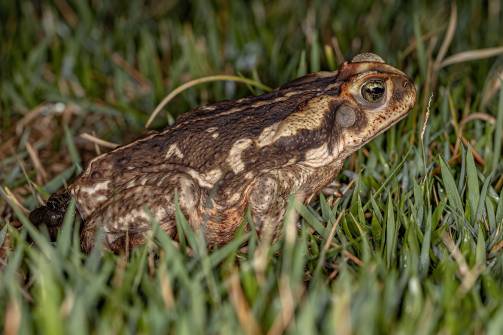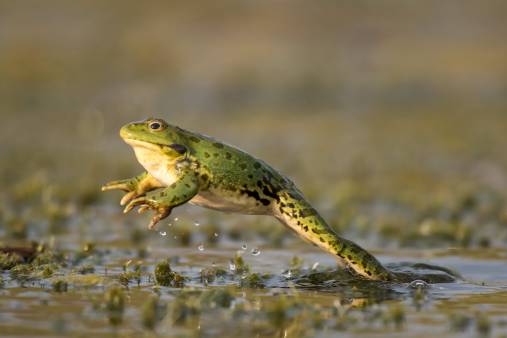Connect with a verified veterinarian in minutes. Licensed vets are available 24/7 to answer your questions. No need to worry about your furry family member.
When you see a frog, they look so much different than other animals and people. Many wonder if frogs have backbones. That’s a great question!
If you’re wondering if frogs have backbones, then you’ve come to the right place. In this article, we’ll answer that question and provide more information on the frog’s skeleton! Let’s get started!
Do Frogs Have Backbones?
The simple answer is yes. Frogs, and other amphibians, do have backbones. All animals fall into two different categories—vertebrate or invertebrate. A vertebrate is an animal that has a backbone, while an invertebrate is one that has no backbone. Mammals, birds, reptiles, and amphibians all have backbones. Invertebrates include insects, arachnids, and more.
Frogs are classified as cold-blooded, vertebrate amphibians. They’re in the same class as toads, newts, and salamanders. While frogs do start out as an invertebrate in the tadpole stage, they do have backbones when they’re fully formed frogs.
What Happens During Metamorphosis?
When do bones begin to develop in the frog? Well, let’s take a look at the frog’s change from egg to frog. Once the eggs hatch, they release frog larvae (baby frogs) into the water. At this point, the larvae are very small. However, within a few days, the larvae develop into tadpoles.
Tadpoles resemble fish at this point. They have tails and live completely underwater. They eat vegetation, which is mostly algae. Tadpoles will remain in this state for about 6 to 12 weeks. After that, metamorphosis starts.
It’s during metamorphosis that tadpoles undergo a complete change. For instance, their inner organs (lungs and everything) change over from being fish-like to an animal that can live on land. This means the gills eventually stop functioning, and the lungs take over-breathing. Also, during metamorphosis, the tadpole will develop limbs and lose its tail.
At this time, the tadpole’s cartilage will begin to transform into bone. The frog’s skull, for example, will change from cartilage to bone. This is also when the rest of the skeleton of bone begins to develop.

Review symptoms, medications & behavior to keep your pets healthy with a Vet Online in just minutes.
Ask a Vet Live NowA Frog’s Skeleton
A fully formed frog has a bone skeleton, just like other animals and us. They also have similar organs, including a heart, lungs, stomach, pancreas, liver, gallbladder, intestines, etc.
When you see a frog, notice his limbs. Each frog has four limbs, which includes four legs. The bones in these limbs contain two sections, similar to ours. In the middle, there’s an elbow, too.
Next, notice the frog’s feet. All frogs have five toes on their hind legs but only four on their front legs. That’s different than ours; they also have long “fingers” compared to their body size. Also, notice the difference in frogs’ feet. An aquatic frog has webbing between his “fingers,” while a tree frog has flexible fingers to make it easier to climb. The hind feet are also short and wide, which makes them easier to use as a shovel to move dirt and debris.
Frogs also have a backbone, like us.
Why Do Frogs Have a Backbone?
That’s a good question! Because they’re vertebrate animals, they have a backbone and a spine. The spine is the key here.
The spine of invertebrate animals (including frogs and us) carries nerves that run from the brain down his back. The nerves are protected by bones called vertebrae. From the spine, the nerves branch out to other parts of the body, carrying messages back and forth between the brain and the body.
If a frog’s foot gets hurt, then the nerves in his foot will send this message back up through the spine to the brain. The frog then knows something’s wrong. The spine is essential for the frog’s movement, reactions to his environment, and more. And the backbone protects the spine. This is why frogs have a backbone.
The backbone protects the spinal cord and also provides a framework for the body. It also provides places for muscles to attach, which are responsible for movement. Just as we and other vertebrates benefit from having a backbone, so do frogs.
Other Parts of the Frog Skeleton
Did you know that frogs don’t have a neck like we do? For this reason, frogs aren’t able to turn their heads. However, they do have eyes that can see in many directions.
Below where the neck would be, a frog does have ribs, similar to ours. However, they are true ribs. Instead, the bones fit horizontally across the frog’s body. These bones then attach to the frog’s spine. This is different than humans, where the ribs are attached to the spine by cartilage rather than bone.
Can Frogs Develop Bone Disease?
Yes, they can, unfortunately. One common problem with frogs is that they can develop Amphibian Nutritional Metabolic Bone Disease (NMBD). This condition is caused by several deficiencies in the frog’s environment and diet. These are usually a combination of a lack of UV light, calcium, and vitamin D3. This health issue is the second most common medical problem in amphibians, just after starvation.
Symptoms of this condition in frogs include:
- Spasticity
- The hydrocoelum fills with fluid
- Spinal deformities
- Angular limb deformities
- Bowed jaws
If this condition is caught early, it can be successfully treated. However, if left untreated, the frog will die.
It’s also possible for frogs to suffer from broken bones. For this reason, pet parents should handle their frogs very carefully and avoid dropping them.
Bone Deformities Can Be Genetic in Frogs
It’s also possible that a frog can be born with bone or spinal deformities. Some develop these issues from accidents, but others are caused by genetics. Some frogs are able to live with the deformities; however, they should always be examined by a veterinarian to ensure the animal is not suffering or experiencing poor quality of life.
So, there you have it! We’ve established that frogs do develop a backbone after they go through metamorphosis. In addition, they can suffer from bone deformities or accidents. The main takeaway is that frogs are very similar to us in some ways—backbone and all!
Connect with a verified veterinarian in minutes. Licensed vets are available 24/7 to answer your questions. No need to worry about your furry family member.

Kim
Kim is a talented author, who loves animals especially dogs. She engaged in writing books and articles relating to animals a decade ago. Kim resides in Chicago with her husband and son. The family is the proud owner of a dog and a parrot (Jack and Lily). Kim wanted more than these two pets, but her husband put his foot down... She often visits elementary schools to talk to the kids about what she learned about pets and how they could learn from them.
Review symptoms, medications & behavior to keep your pets healthy with a Vet Online in just minutes.
Ask a Vet Live Now




